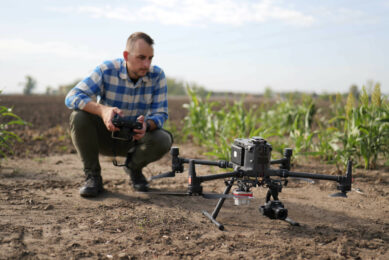Drone spraying delivers high pesticide efficacy and better yield in durian orchards

Chinese drone manufacturer EAVision joined up with German companies BASF and Bayer to improve pesticide efficacy and improve yield in durian orchards in Thailand with drone spraying. The EAVision spraying drones are also saving 90% on water.
Numerous pests cause an economic loss to durian farmers every year. Leaf disease, leaf spot disease, pink disease, psyllids, mealybugs, and fruit borer are the most common pests in the durian trees. Though farmers spent an average of 40% of their income on chemicals, usually the improvements remain limited.
Advantages of drone spraying
“The conventional treatment method causes serious problems with flushing and spraying. And the efficiency of manual operation is low, causing farmers to miss the optimal period of plant protection.”
The company, that uses its new EA-30X drones in the research project, points out that drones offer farmers more efficient solutions to protect their durian fruits, save on labour and can also help to increase yield. “Two people and one drone can routinely complete 40 to 50 hectares per day, and two people using a traditional spraying method can only complete 0.3 to 0.5 hectares per day, and the disparity in spreading efficiency is even greater”, Mr Liu says.
Text continues below video
An efficacy of 95% with drone spraying
During the project, drones are used to complete droplets distribution of chemicals from the top of trees to the lower end of the trees. Leaves are sprayed front and back. This results in an efficacy of 95%, according to EAVision. Other spraying technologies reach mainly the lower end of the trees and the front of the leaves. The use of a pump with a long hose nozzle on average results in an efficacy of 50%. Air-blast sprayers reach an efficacy of 80%.
The drones are easy to operate and save 90% on water, the company points out. With the drone spraying in Thailand, water consumption is 45 to 75 litre per hectare. Using a pump with a long hose nozzle can easily results in the consumption of 1000 litre per ha. Air-blast spraying uses 2,000 litres per hectare, according to the researchers involved. The EAVision drones can also be operated at night and in hills.
Text continues below image

High-definition maps
The drones also help to increase yield productivity. The drone-sprayers can obtain high-definition maps, elevation information and information on crop distribution. They give farmers the tools for precision planting management, including intelligent monitoring and precise variable operations.
The EAVision-project in Thailand – and a project with palm trees in Indonesia – are still running and the findings are being verified. BASF and Bayer are investors in the project. The companies provide the needed agrochemicals and verify the efficacy of the EAVision-drones.
Also read:What to look for when buying your first application drone
A faster and safer application strategy
According to Bayer, drone spraying reduces the overall volume of solution application compared with the cover-all-strategy of most human-led spraying. “Beyond elevating yield potential, multi-rotor drones present a faster, safer application strategy compared to hand spraying. Autonomous loading and distribution capabilities limit human exposure to crop protection solutions”, the company says.
The main advantage of drone application is the ability to apply just the right amount of treatment in the locations where it is needed, says Bayer. If suitably designed, adjuvants in crop protection products can ensure a targeted delivery of active ingredients at lower spray volumes and dramatically advance farmers’ management potential.
Superior object detection allows for safe navigation
BASF Venture is also a strategic investor in EAVision. “When flying over hilly areas, EAVision UAVs afford exceptional stability”, the company emphasises. “In mixed tree crop vegetations with complicated gradients, superior object detection allows for safe navigation. These are coupled with its patented mist sprinkler that allows the vehicles to get as close as one meter from the crown of the vegetation to enable targeted input application. This precision significantly reduces off-target drifting into the environment, improving producer wellbeing, and supporting sustainability objectives.”
The advantages of EAVision’s UAVs are also proven in field applications across China, including in mountainous fruit farms where tree height differences are as much as 10 meters. In a Southwest Chinese sugarcane farm, compared to traditional farm workers, its drones have maintained the same output, working 50 times faster while boosting sugar levels by 3%. In a citrus farm in the Guangxi province, drones delivered a 90% improvement over traditional labour in preventing spider mites.
Want to know what agricultural drones are currently commercially available? Future Farming introduced ten new application drones in its drone catalogue this year. Check out the 2022 Drone Catalogue.
Join 17,000+ subscribers
Subscribe to our newsletter to stay updated about all the need-to-know content in the agricultural sector, two times a week.



